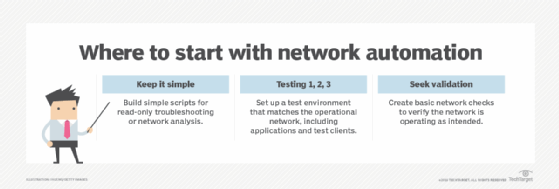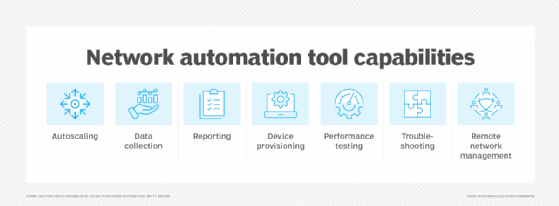What is network automation?
Network automation is a process that uses intelligent software to automate the management, configuration, deployment, testing and operation of both physical and virtual devices. It is used by enterprises and service providers to improve efficiency, reduce human error and lower operating expenditure (Opex).
Network automation tools support functions of modern IT infrastructure ranging from basic network mapping and device discovery to more complex workflows, such as network configuration management and the provisioning of virtual network resources.
Network automation also plays a key role in software-defined networking (SDN), network virtualization and network orchestration, enabling automated provisioning of virtual network tenants and functions, such as virtual load balancing.
How does network automation work?
Network automation is similar to software programming because it uses comparable logic and frameworks to manage and schedule the automation of various tasks. Common "if X, then Y" decision statements are used to program automation into the network.
Administrators can use tools that are integrated into the networking platform. Alternatively, they can create and execute automation scripts for network components by using first- or third-party software.
Modern SDN platforms use a centralized control plane and often have commonly used and prebuilt automation tasks that can be adjusted and scheduled. Alternatively, network teams can use external tools to create scripts and execute them via command-line interface (CLI) or application programming interface (API). Historically, the CLI has been a common tool for network automation. However, it requires technical expertise and can be challenging to scale for larger deployments. More recent methods use APIs and graphical user interfaces (GUIs) to offer more user-friendly and scalable options.
With the introduction of artificial intelligence (AI) and machine learning, advanced network automation capabilities are now being widely used. These advanced automation options analyze metadata and use model-driven network programmability to learn network patterns. As a result, they can deliver predictive analytics and offer valuable recommendations.
Common examples of automated network tasks used in production environments include the following:
- Bandwidth forecasting for internet and wide area network (WAN) links.
- Network and device inventory and monitoring.
- Service-level agreement monitoring and alerting.
- Automated network configuration backups.
- Mass configuration changes across multiple networks and clouds.
- Access port turn-ups and turn-downs based on employee onboarding and offboarding information.
- Zero-touch provisioning to automate the setup of new network devices, including IP assignment, interface configuration and security policy application.
- Automated threat detection and response.
Types of network automation
Automation can be employed in any type of network, including local area networks, WANs, data center networks, cloud networks and wireless networks. In short, any network resource controlled through a CLI or an API can be automated.
The following are some common types of network automation.
Script-driven network automation
Script-driven network automation employs scripting and programming languages to execute tasks, ideally those with precise triggers and consistent procedures. Legacy languages, such as Perl and Tcl, remain prevalent in network automation due to their familiarity.
As networks continue to become more complex, newer open source programming languages, such as Ansible, Python and Ruby, have grown in popularity for their ease of use and flexibility. Other programming languages for network automation include Bash and Go.
Software-based network automation
Software-based network automation, often referred to as intelligent network automation, is coordinated through an administrative portal that eliminates the need to script commands manually. These platforms typically provide templates to create and execute tasks based on plain language policies.
Intent-based network automation
The latest network automation includes the use of AI and machine learning to understand user and business intent and automatically modify how network policy is enforced based on this knowledge. Network administrators create performance service levels for applications and users. When these service levels are not met, the network automatically adjusts -- as best it can -- to bring business-critical application performance levels back in line.
Network orchestration automation
This type of network automation coordinates and automates the deployment and management of network services and applications. It's typically used to deploy virtual networks, load balancers and firewalls. Common examples used for carrying out network orchestration include Terraform and OpenStack.
API-based network automation
API-based network automation uses APIs to interact with network devices and systems. It's typically used to integrate network automation with other systems, automate complex workflows and build custom automation options.
Security automation
Security automation focuses on automating security-related tasks, such as applying patches, enforcing security policies and monitoring for vulnerabilities. This type of automation helps organizations to maintain compliance and protect their networks from threats more effectively.
Cloud network automation
As organizations increasingly adopt cloud services, cloud network automation has become a critical component. It automates the management of cloud-based network resources, making sure they are provisioned, configured and monitored effectively within cloud environments.
Data center automation
This type of network automation focuses on automating tasks specific to data center operations, such as resource allocation, load balancing and performance monitoring. Data center automation helps optimize resource utilization and improve operational efficiency.

Benefits of network automation
Some common benefits of network automation include the following:
- Improved efficiency and network optimization. By automating functions on network devices, humans no longer have to perform time-consuming and rudimentary tasks.
- Reduced likelihood of human error. Manual tasks are prone to human error, which can cause network outages and revenue loss. The consequences of a miscalculation or incorrect entry can be significant. Setting up a task for automation means it only needs to be entered correctly once. Network automation also automates the network lifecycle management of applications, enabling the completion of operational tasks more quickly, efficiently and without errors. Network engineers can easily revert automated changes in case of error and adjust as needed.
- Lower Opex. By eliminating certain manual tasks for network management and device provisioning, businesses can operate with greater speed and agility. For example, automated provisioning might save a network engineer from traveling to a new branch office to establish network connectivity, thus enabling employees at that site to get to work faster.
- Enhanced security. Automated systems enforce security policies consistently, confirming network-wide compliance with the latest security standards. This proactive approach facilitates vulnerability identification and rapid patch deployment, minimizing exposure to threats and enhancing the overall security posture of an organization.
- Scalability. To accommodate growth, networks must scale effectively. Network automation simplifies the process of adding new devices and services, enabling businesses to expand their network infrastructure while minimizing the burden on IT teams and ensuring efficient resource utilization.
- Cost-efficiency. Network automation improves cost-effectiveness by streamlining operations. Automating repetitive tasks reduces manual effort and minimizes human error, lowering operational expenses. Optimized resource allocation and faster troubleshooting also minimize downtime, which further enhances cost savings.
Network automation challenges
Network automation initiatives can pose significant challenges for certain IT organizations. Some common challenges of network automation include the following:
- Network device incompatibility. Many legacy network devices are locked into proprietary ecosystems and cannot tap into APIs. This limits the types of automation tools that can be used, as well as the effectiveness of network automation capabilities.
- Tool complexity. Automation tools can create added complexity, especially when AI and machine learning are added to the mix. Given the complexity of modern networks, with their diverse equipment and fragmented data silos, the initial investment and tools required to break down these silos and enable network automation can be significant.
- Distributed networks. Hybrid and multi-cloud environments that are incompatible with certain automation tools can hinder efficiency and scalability.
- Cultural shift. Successful network automation requires a significant cultural shift. Network administrators might initially resist automation, fearing a loss of control over their responsibilities. While automation minimizes human error, misconfigurations can lead to critical outages, emphasizing the need for complete understanding and buy-in from the entire team.
- Skills gap. One of the main challenges in network automation is the skills gap. It can be difficult to find and retain skilled individuals who are proficient in automation tools and scripting languages. Additionally, training existing staff in these technologies often demands substantial time and resources.
- Testing and validation. Network automation requires thorough testing and validation to guarantee that automated processes function as intended. This requires a strong testing framework and continuous monitoring, both of which can be resource-intensive.
Network automation tools and languages
Several interfaces, platforms and protocols are available for enterprise network teams to set up network automation. The CLI is the most traditional vehicle for deploying network automation. Though freely available, time-tested and highly customizable, it requires proficiency in CLI syntax and doesn't scale well in certain distributed infrastructure environments.
Automation software products can combine network tasks into prebuilt programs that users can select, schedule and execute from the app's front end. These tasks are packaged into playbooks, which include APIs, plugins, inventories and modules. Users can browse, choose and run these playbooks to automate various network functions such as configuration, security, orchestration and provisioning across service providers. A variety of open source tools -- including Ansible, Chef and Puppet -- offer network automation frameworks. These tools typically offer a library of common commands or workflows that can easily be repeated.
Commercial network automation tools are also available. Most network infrastructure vendors have developed software-based platforms that provide automation capabilities, typically for their own products, through a specialized API. More recently, network manufacturers are offering open API access to their network equipment hardware and software. Thus, many third-party tools can now be used to automate networks in multivendor environments.
According to Gartner reviews, some of the leading vendors for network automation platforms include SolarWinds Network Configuration Manager, NetBrain Next-Gen, AlgoSec Security Management Suite, ManageEngine Network Configuration Manager, BackBox and Red Hat Ansible Automation Platform.
Common programming languages typically used in network automation as mentioned above include Python, Bash, Ruby, Tcl and Go.

Best practices for network automation
The integration of network automation into production networks should not be taken lightly. Careful planning is required to make sure the right policies, tools and mindset are in place before automated processes can commence.
Best practices for network automation integrations include the following:
- Perform a thorough network device inventory.
- Identify processes that can be automated.
- Research the automation tools that work best in a given infrastructure.
- Enforce security measures such as access controls, encryption and regular audits to protect against vulnerabilities and ensure that automated processes do not expose the network to risks.
- Test automation scripts and configurations thoroughly in a controlled environment to identify issues before deployment.
- Start with basic network automation processes and slowly add more complex tasks.
- Use version control to manage automation scripts and configurations and to enable teams to track changes and revert to previous versions if needed. Maintain detailed documentation of all automated processes, configurations and workflows for troubleshooting, onboarding and team collaboration.
Examples of network automation
Network automation can be applied in various scenarios to enhance efficiency and reliability in network management.
The following are some examples and use cases of network automation:
- Automated configuration management. Using tools such as Ansible, Puppet or Chef, organizations can automatically configure routers, switches and firewalls across their entire network, including setting up virtual LANs, IP addressing and security settings on thousands of devices. For example, a large enterprise with thousands of switches and routers can automate configuration.
- Automated monitoring and alerts. Organizations can use tools to automatically monitor the health and performance of network devices, alerting administrators to issues such as high latency, packet loss or device failures. For example, a telecom company can automatically detect outages or performance degradation and trigger alerts to on-call engineers for immediate attention.
- Cloud network automation. Network automation can be used to automate the configuration of virtual networks in cloud environments including AWS, Azure or Google Cloud, using cloud-native tools such as AWS CloudFormation or Azure Resource Manager. For example, a company deploying multiple microservices in the cloud can automate the configuration of their virtual private network (VPN) to guarantee secure communication between services.
- Self-healing networks. Advanced network automation can deploy self-healing capabilities, where the network automatically detects issues and applies predefined corrective actions. For example, if a link goes down, the system can reroute traffic to maintain connectivity without human intervention.
- Integration with continuous integration/continuous delivery pipelines. In DevOps environments, network automation can be integrated into CI/CD pipelines. This enables automated testing and deployment of network configurations alongside application updates, ensuring network changes are synchronized with application changes.
- Automated backup and recovery. Network automation can streamline the backup process for configurations and critical data. Automated scripts can regularly back up device configurations and restore them quickly in case of failures, ensuring business continuity.
Future of network automation
Network automation is one of the key methodologies supporting the evolution of intent-based networking and network validation. These concepts use software to map how enterprises can harness their resources to meet the business demands their networks need to support.
The future of network automation is poised for significant advancements driven by several key trends, especially in AI and machine learning, which will enable self-healing networks capable of proactively predicting and addressing issues, optimizing performance using real-time data and adapting to changing network conditions with minimal human intervention. This will result in more efficient and resilient network operations across cloud, edge and traditional data center environments.
Besides self-healing networks, there are some other key trends shaping the future of network automation, including the following:
- Network hyperautomation. Network hyperautomation is a growing trend in network automation. It involves automating all or most of the network management workflows to eliminate human intervention, including error correction and troubleshooting. Achieved through an orchestration platform, hyperautomation provides a centralized view of the entire network architecture and automated processes, enabling monitoring and manual intervention when needed. This reduces manual work and minimizes the risk of human error.
- Vendor-agnostic options. The future of network automation is moving toward vendor-agnostic options that offer flexibility by supporting open hardware, Linux-based systems and orchestration platforms that integrate with third-party tools. These platforms enable centralized network automation without gaps, offering easy adoption of new technologies such as AIOps, which uses AI to predict and prevent cybersecurity threats. Vendor-agnostic options also eliminate the need for proprietary hardware so organizations can stay up to date with advanced technologies while maintaining seamless integration.
- Infrastructure as code. IaC is becoming a key element in the future of network automation, helping teams to define and manage network configurations through code. This approach enhances automation, version control and consistency and supports agile, scalable and efficient network management. As IaC integrates more with network automation tools, it will continue to align with digital transformation trends that improve operational efficiency and performance. Additionally, combining IaC with AI and machine learning will further enhance network adaptability and self-management, turning it into a foundational component of future network automation.
- Zero-trust security. As cyberthreats and security breaches continue to rise, zero-trust security principles are becoming crucial to network automation strategies. These architectures enforce stringent access controls, authentication and encryption measures to ensure only authorized users and devices can access network resources, regardless of their location.
- Software-defined networking and network functions virtualization. SDN and NFV are vital to the future of network automation as they support more flexible, programmable and efficient network management. SDN centralizes control of the network to permit dynamic configuration and optimization, while NFV decouples network functions from hardware, facilitating rapid deployment and scalability of services.
The future of networking is automated. Discover the essential skills, from soft skills to AI integration, needed to thrive in this evolving landscape.







